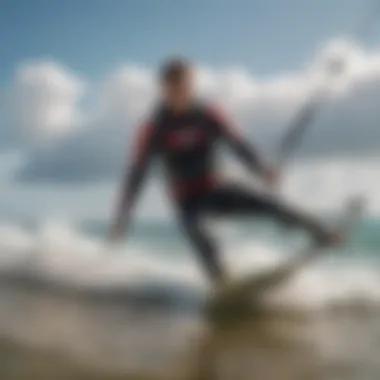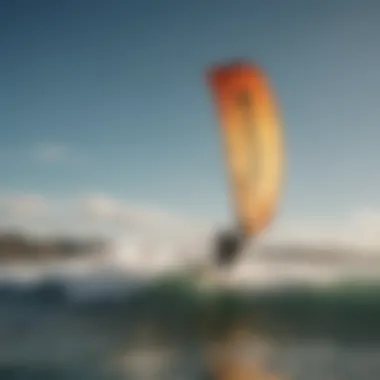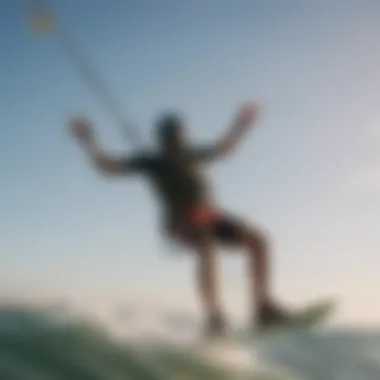Ultimate Guide to Mastering the Kite Surfing Set-Up Process


Equipment Reviews
As we delve into the world of kite surfing, a crucial aspect that demands intricate attention is the selection of kites. These flying companions come in a myriad of shapes, sizes, materials, and brands, each tailored to cater to specific demands of the riders. From delta shapes to C-shapes, and varying sizes from 5 to 17 square meters, understanding the dynamics of each kite is fundamental to optimizing performance on the waves. We will explore the latest models in detail, dissecting their features and discussing how they influence one's kite surfing experience.
When it comes to boards, kiteboarding enthusiasts are met with a diverse array of options, from twintips designed for freestyle tricks to directional boards ideal for wave riding. The design, construction, and riding style suitability are paramount considerations when selecting the right board. Whether you prefer a shorter, more maneuverable twintip or a longer, stability-focused directional board, comprehending the nuances of each type is key to enhancing your time on the water.
The realm of kiteboarding accessories is replete with vital components that ensure a safe and enjoyable outing. Harnesses, lines, pumps, and safety gear constitute the backbone of a well-equipped kite surfer. Delving into the specifics of each accessory, we will elucidate their roles in enhancing performance, ensuring safety, and addressing potential challenges on the water. Properly understanding and utilizing these accessories can make a marked difference in the overall kite surfing experience.
Gearing Up for Success
In the realm of kite surfing, mastering the process of gearing up is paramount to achieving success. The gear you choose can significantly impact your performance on the waves, making it crucial to select the right equipment tailored to your preferences and skill level. When preparing for a kite surfing session, the process of gearing up encompasses choosing the appropriate kite and board, ensuring the lines and bar are set up correctly, checking the harness and safety systems, understanding wind dynamics, and prioritizing safety measures. Each of these components plays a vital role in enhancing your kite surfing experience and overall safety.
Choosing the Right Kite
When it comes to choosing the right kite for your kite surfing adventure, several considerations come into play. The size and type of kite you select will directly affect your ability to harness the wind's power effectively and maneuver across the water. Understanding the wind conditions at your kite surfing spot is essential in determining the appropriate kite size and type to use. Factors such as wind strength, gustiness, and overall weather patterns should influence your decision. Opting for a kite that matches your skill level and riding style is imperative for a seamless and enjoyable experience on the water.
Selecting the Appropriate Board


Selecting the appropriate board is another crucial aspect of the kite surfing set-up process. The board you choose should align with your preferences, riding abilities, and the prevailing water conditions. Factors such as board size, shape, fin setup, and construction materials all play a role in determining how the board performs on the water. When picking a board, it is essential to consider aspects like rider weight, wind conditions, and riding goals to ensure the board's suitability. Finding the right balance between stability, maneuverability, and control is key to maximizing your kite surfing sessions.
Preparing Your Equipment
In the realm of kite surfing, the significance of preparing one's equipment cannot be overstated. This crucial step sets the foundation for a safe and exhilarating experience on the waves. When it comes to kitesurfing, attention to detail is paramount. Properly setting up your equipment not only ensures smooth performance but also minimizes the risk of accidents or malfunctions during your session.
As you embark on your kite surfing journey, taking the time to prepare your gear meticulously can make all the difference. Whether you are a seasoned rider or just starting out, investing effort in this initial phase lays the groundwork for a successful and enjoyable ride. From checking the lines and bar to inspecting the harness and safety systems, each element plays a pivotal role in your overall experience.
Setting Up the Lines and Bar
Proper line untangling and bar assembly
When it comes to kite surfing, mastering the art of proper line untangling and bar assembly is key to a seamless ride. The lines are the bridge between you and the kite, dictating control and maneuverability. Ensuring that the lines are untangled and correctly attached to the bar is essential for a hassle-free session.
A unique feature of proper line untangling and bar assembly lies in its precision. Each knot and connection must be secure, maintaining the integrity of the setup. This meticulous approach not only enhances safety but also guarantees fluid movements and responsive handling. By prioritizing this aspect of preparation, kite surfers can optimize their performance and make the most of their time on the water.
Checking Harness and Safety Systems


Ensuring secure harness fitting and safety mechanisms is a critical step in the kite surfing set-up process. The harness serves as a crucial link between you and the kite, providing support and control during your ride. By double-checking the fitting of the harness and inspecting the safety systems, riders can minimize the risk of accidents and enhance their overall safety.
One of the standout features of ensuring secure harness fitting and safety mechanisms is the confidence it instills in riders. A properly fitted harness offers stability and comfort, allowing kite surfers to focus on their technique without distractions. Moreover, the presence of reliable safety mechanisms provides a safety net in case of unexpected situations, giving riders peace of mind as they tackle the waves.
Understanding Wind Dynamics
When delving into the intricacies of kite surfing, understanding wind dynamics emerges as a pivotal aspect that directly influences the success and safety of the experience. The ability to grasp how wind behaves, its patterns, and strengths is crucial as it dictates one's control over the kite and overall maneuverability. By comprehending wind dynamics, kite surfers can optimize their techniques, adjust their movements according to wind variations, and enhance their performance on the waves. This knowledge not only elevates the rider's skill level but also ensures a more enjoyable and productive kitesurfing session.
Grasping Wind Patterns
In kitesurfing, having a solid grasp of prevailing wind patterns and their impact on kite control is a game-changer. The knowledge of how winds flow in a particular area, understanding wind shifts, gusts, and lulls, allows riders to anticipate and adapt their maneuvers accordingly. The ability to harness the power of the wind efficiently, depending on its direction and speed, empowers kitesurfers to execute precise movements and maintain control over their kites. This understanding of wind patterns significantly contributes to the safety and performance of riders, enabling them to navigate varying wind conditions with agility.
Knowledge of prevailing winds and impact on kite control
Among the specific aspects of kite surfing, understanding the knowledge of prevailing winds and their impact on kite control stands out for its critical role in enhancing the rider's competency. By recognizing how prevalent winds affect kite behavior, riders can anticipate changes in speed and direction, adjust their positioning, and fine-tune their control techniques. This profound understanding of wind patterns gives riders a strategic advantage, allowing them to stay ahead of the wind and make informed decisions to optimize their kitesurfing experience.
Utilizing Wind Power


An essential skill in kite surfing is the adept utilization of wind power to maneuver the kite effectively and ride the waves with skill and finesse. By adjusting their techniques based on wind strength, kitesurfers can harness the energy of the wind to propel themselves across the water surface and perform aerial maneuvers. Adapting to varying wind intensities, whether light breezes or strong gusts, demands proficiency in adjusting body posture, kite angles, and movements to leverage wind power optimally.
Adjusting technique based on wind strength
The ability to adapt one's technique according to the prevailing wind strength is instrumental in maximizing performance and safety during kite surfing sessions. Ensuring alignment between kite control and wind conditions is paramount to prevent mishaps and achieve seamless transitions between different maneuvers. By understanding how to modify their approach based on wind intensity, kitesurfers can maintain stability, control, and agility throughout their ride, showcasing mastery over the elements for an exhilarating and rewarding kitesurfing experience.
Prioritizing Safety Measures
In the realm of kite surfing, prioritizing safety measures stands as a paramount endeavor for every rider, accentuating the delicate balance between thrill and security that characterizes this exhilarating water sport. As the foundation upon which every successful kite surfing session is built, safety measures encompass a myriad of crucial protocols and practices that safeguard the rider against potential risks and ensure a smooth and secure experience on the waves. While the adrenaline rush of soaring through the air propelled by wind power is undeniably enticing, it is imperative for every kitesurfer, from novices to seasoned athletes, to internalize the significance of adhering rigorously to safety measures.
Performing Equipment Checks
For any kitesurfer, conducting thorough equipment checks before embarking on a session is a non-negotiable ritual that underpins a safe and enjoyable experience on the water. Amidst the bustling activity on the beach and the alluring call of the waves, taking the time to meticulously inspect every gear component can be the differentiating factor between a successful ride and a potentially hazardous outing. Whether it is scrutinizing the bridle lines for signs of wear and tear or ensuring that the safety release mechanisms are functioning optimally, each element of the equipment check plays a pivotal role in mitigating potential risks and enhancing rider safety. By embracing the discipline of regularly inspecting gear for wear and tear, kitesurfers exhibit a proactive commitment to their safety and well-being, thereby fortifying their confidence and preparedness to navigate the unpredictable waters with agility and poise.
Inspecting gear for wear and tear
At the core of the equipment check ritual lies the meticulous examination of gear for wear and tear, a practice fundamental to preempting any potential malfunctions or safety hazards during a kite surfing session. By scrutinizing the kite canopy for abrasions, inspecting the lines for fraying, and checking the harness for secure fastenings, kitesurfers equip themselves with the foresight and awareness necessary to address any equipment discrepancies before they escalate into critical issues. This detailed inspection process serves as a shield against unforeseen mishaps, highlighting the kitesurfer's commitment to meticulous preparation and dedication to their craft. Through the conscientious evaluation of gear condition, kitesurfers embrace a culture of safety consciousness that not only enhances their individual riding experience but also contributes to fostering a community of responsible and vigilant water sports enthusiasts.
Implementing Emergency Protocols
Amidst the dynamic setting of kite surfing where factors like wind speed and wave height can swiftly morph, implementing robust emergency protocols emerges as a linchpin in ensuring rider safety and well-being. As the ultimate contingency plan devised to address unforeseen circumstances or sudden equipment failures, understanding emergency release systems equips kitesurfers with the knowledge and proficiency to navigate potentially critical scenarios with composure and efficacy. In the event of a sudden loss of control or an entangled harness, the ability to swiftly activate emergency release systems can spell the difference between a minor hiccup and a full-blown emergency situation. By familiarizing themselves with the nuances of diverse emergency protocols and practicing their seamless execution, kitesurfers fortify their readiness to confront adversity head-on and emerge unscathed from challenging situations.
Understanding emergency release systems
Within the spectrum of emergency preparedness, grasping the mechanics of emergency release systems assumes pivotal importance, offering riders a lifeline of defense when faced with unexpected perils on the water. Whether it is comprehending the intricacies of quick-release harness mechanisms or acquainting oneself with kite depower systems, delving into the nuances of emergency release systems furnishes kitesurfers with the confidence and assurance to navigate crises deftly. The seamless integration of emergency release systems into one's repertoire not only elevates the level of safety and preparedness during kite surfing sessions but also instills a sense of self-reliance and empowerment within each rider. By treating emergency protocols as indispensable tools rather than mere last-resort contingencies, kitesurfers cultivate a culture of resilience and readiness that propels them towards ever greater heights of mastery and proficiency in the realm of kite surfing.







